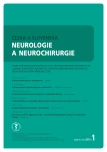Spinal Epidural Lipomatosis – Three Case Reports
Authors:
T. Andrašinová 1; B. Adamová 1,2; J. Stulík 3; J. Beck 1; K. Starý 4; S. Voháňka 1,2; Z. Bálintová 5
Authors‘ workplace:
Neurologická klinika LF MU a FN Brno
1; CEITEC – Středoevropský technologický institut, MU, Brno
2; Radiologická klinika LF MU a FN Brno
3; Interní gastroenterologická klinika LF MU a FN Brno
4; Klinika dětské neurologie LF MU a FN Brno
5
Published in:
Cesk Slov Neurol N 2016; 79/112(1): 93-99
Category:
Case Report
doi:
https://doi.org/10.14735/amcsnn201693
Overview
Spinal epidural lipomatosis (SEL) is a condition associated with pathological fat accumulation in the epidural area of the spinal canal. The disorder is likely caused by the use of corticosteroids, obesity, endocrinal disorders (especially endogenous overproduction of cortisol), although, in some cases, no cause is immediately evident. SEL rarely becomes symptomatic unless it leads to compression of the spinal cord or nerve roots. Clinical manifestation depends on the level at which the spinal canal is affected. Severity of compression of nerve structures and the corresponding intensity of clinical syndrome are the most important factors in the choice of SEL therapy. Recent classifications for evaluation of epidural fat layer on radiographic images by Borré (for lumbar spine) and Quint (for thoracic spine) can help in guiding the diagnostic and treatment approaches. Therapeutic options include conservative therapy (reduction of body weight, reduction of any corticoid dosage, treatment of the endocrinal disorder, analgesics, rehabilitation) and surgical decompression. However, SEL itself is rare and is frequently found together with other (e.g. degenerative) spinal changes. We report three cases from our own patient base through which we demonstrate possible causes, course and therapy of this disorder. Lipomatosis manifested as cauda equina syndrome in the first patient, as radicular syndrome in the second, and SEL led to compression of the thoracic spinal cord in the third.
Key words:
spinal epidural lipomatosis – epidural fat – spinal canal – stenosis
The authors declare they have no potential conflicts of interest concerning drugs, products, or services used in the study.
The Editorial Board declares that the manuscript met the ICMJE “uniform requirements” for biomedical papers.
Sources
1. Sato M, Yamashita K, Aoki Y, Hiroshima K. Idiopathic spinal epidural lipomatosis. Case report and review of literature. Clin Orthop Relat Res 1995; 320: 129– 134.
2. Lee M, Lekias J, Gubbay SS, Hurst PE. Spinal cord compression by extradural fat after renal transplantation. Med J Aust 1975; 1(7): 201– 203.
3. Muñoz A, Barkovich JA, Mateos F, Simón R. Symptomatic epidural lipomatosis of the spinal cord in a child: MR demonstration of spinal cord injury. Pediatr Radiol 2002; 32(12): 865– 868.
4. Artner J, Leucht F, Cakir B, Reichel H, Lattig F. Spinal epidural lipomatosis. Orthopade 2012; 41(11): 889– 893. doi: 10.1007/ s00132-012-1966-z.
5. Fogel GR, Cunningham PY, Esses SI. Spinal epidural lipomatosis: case reports, literature review and meta-analysis. Spine J 2005; 5(2): 202– 211.
6. Starý M, Rosík S. Spinální epidurální lipomatóza. Neurol Prax 2007; 1: 39– 41.
7. Borré DG, Borré GE, Aude F, Palmieri GN. Lumbosacral epidural lipomatosis: MRI grading. Eur Radiol 2003; 13(7): 1709– 1721.
8. Fassett DR, Schmidt MH. Spinal epidural lipomatosis: a review of its causes and recommendations for treatment. Neurosurg Focus 2004; 16(4): E11.
9. Kuhn MJ, Youssef HT, Swan TL, Swenson LC. Lumbar epidural lipomatosis: the „Y“ sign of thecal sac compression. Comput Med Imaging Graph 1994; 18(5): 367– 372.
10. Fessler RG, Johnson DL, Brown FD, Erickson RK, Reid SA, Kranzler L. Epidural lipomatosis in steroid-treated patients. Spine 1992; 17(2): 183– 188.
11. Roy-Camille R, Mazel C, Husson JL, Saillant G. Symptomatic spinal epidural lipomatosis induced by a long-term steroid treatment. Review of the literature and report of two additional cases. Spine 1991; 16(12): 1365– 1371.
12. Sandberg DI, Lavyne MH. Symptomatic spinal epidural lipomatosis after local epidural corticosteroid injections: a case report. Neurosurgery 1999; 45(1): 162– 165.
13. Voháňka S. Méně časté příčiny komprese v bederním úseku. In: Mičánková Adamová B (ed.). Lumbální spinální stenóza. 1. vyd. Praha: Galén 2012: 37– 40.
14. Jaimes R, Rocco AG. Multiple epidural steroid injections and body mass index linked with occurrence of epidural lipomatosis: a case series. BMC Anesthesiol 2014; 14: 70. doi: 10.1186/ 1471-2253-14-70.
15. Quint DJ, Boulos RS, Sanders WP, Mehta BA, Patel SC, Tiel RL. Epidural lipomatosis. Radiology 1988; 169(2): 485– 490.
16. Sugaya H, Tanaka T, Ogawa T, Mishima H. Spinal epidural lipomatosis in lumbar magnetic resonance imaging scans. Orthopedics 2014; 37(4): e362– e366. doi: 10.3928/ 01477447-20140401-57.
17. Pinkhardt EH, Sperfeld AD, Bretschneider V, Unrath A, Ludolph AC, Kassubek J. Is spinal epidural lipomatosis an MRI-based diagnosis with clinical implications? A retrospective analysis. Acta Neurol Scand 2008; 117(6): 409– 414.
18. Pouchot J, Si-Hassen C, Damade R, Bayeux MC, Mathieu A, Vinceneux P. Cauda equina compression by epidural lipomatosis in obesity. Effectiveness of weight reduction. J Rheumatol 1995; 22(9): 1771– 1775.
19. Ďurovcová V, Kršek M. Cushingův syndrom – charakteristika, diagnostika a léčba. Med Prax 2009; 6(6): 295– 299.
20. Stephenson W, Kauflin MJ. Unusual presentation of spinal lipomatosis. Int Med Case Rep J 2014; 7: 139– 141. doi: 10.2147/ IMCRJ.S54456.
21. Wells AJ, McDonald MJ, Sandler SJ, Vrodos NJ. Lumbosacral epidural lipomatosis causing rapid onset cauda equina syndrome. J Clin Neurosci 2014; 21(7): 1262– 1263. doi: 10.1016/ j.jocn.2013.09.027.
Labels
Paediatric neurology Neurosurgery NeurologyArticle was published in
Czech and Slovak Neurology and Neurosurgery

2016 Issue 1
Most read in this issue
- Investigation of the Retinal Nerve Fiber Layer in Multiple Sclerosis Using Spectral Domain Optical Coherence Tomography
- Sympathetic Skin Response in the Diagnosis of Small Fibre Neuropaty
- Complications of Cranioplasty after Decompressive Craniectomy
- Indications for Decompressive Craniectomy
